Minimally invasive table tops
and veneer restoration
It does not always have to be a crown
Modern dentistry means following a minimally invasive approach in every aspect of a treatment. The video of Dr. Jürgen Wahlmann’s speech shows that minimally invasive table tops and veneer restorations are safe and predictable solutions, provided that all preparation rules are followed to the letter and the minimum layer thicknesses are meticulously observed.
Fascinating treatment cases
What would I wish for if I was sitting on the treatment chair? Dr. Wahlmann demonstrates by means of various clinical cases how minimally invasive table tops and veneer restorations meet patient requirements, both from a functional and an aesthetic aspect. With these techniques, a lot of precious hard dental substance can be saved, and Dr. Wahlmann’s genuine enthusiasm for these techniques shines through during the entire video.
He also praises the dental laboratory for their excellent work – especially their impressive ability to create perfect layers of material – which led to outstanding treatment results. This makes the video a true highlight and interesting viewing for dentists and dental technicians alike. Such excellent results can only be achieved if all parties involved work together hand in hand.
The video also shows cases where the measurements were not taken by means of a face-bow, but with a PlaneFinder® (Zirkonzahn GmbH). The PlaneFinder registers the natural posture of the patient’s head, any asymmetries of the dental arch in relation to the head posture are identified and the inclination of the occlusal plane is measured.
Tips for the preparation for table tops
How do you find an elegant way of preparing to exactly the right extent – enough to be effective, but not too much? Dr. Wahlmann loves using the PrepMarkers (set 4663) for minimally invasive table tops. He just pulls the instrument through the central fissure, from mesial to distal and from vestibular to lingual.
The instrument marks the exact depth stop – and not a smidgen more. Dr. Wahlmann also mentions the OccluShaper 370 from the Occlusal Onlay Set 4665ST. Guided from mesial to distal, the instrument marks a rounded shape with a concave centre. This is followed by the 8849P, a preparation diamond with a guide pin and a working length of 4 mm. This instrument is used for preparing the vestibular and oral sides in a predictable manner while observing the desired removal depth.
Another firm favourite: Sonic tips
The video shows that Dr. Wahlmann has now become a great fan of sonic tips. With regard to the preparation for minimally invasive table tops, this means that the sonic tips SFM6 and SFD6 – of identical shape and diamond coated on one side only – ensure that the desired shape is exactly adhered to, even in cases of a low removal depth, while the adjacent teeth remain intact.
Minimally invasive veneer restoration
Dr. Wahlmann is particularly impressed with the centre piece of the new Perfect Veneer Preparations (PVP) Set 4686ST, the depth marker 868BP provided with 3 depth marks and a guide pin. In his video, he explains how this instrument makes absolutely sure that too deep a preparation can be ruled out. It is impossible to use the instrument incorrectly – as is the case with all the above described instruments that specify the exact parameters of a safe, minimally invasive preparation for table top restorations.
